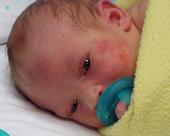How does spina bifida affect a child?
In the embryo, there is a tiny ribbon of tissue that folds inward to form a tube. This structure, called the neural tube, forms by the 28th day after conception. When this process goes awry and the neural tube does not close completely, defects in the spinal cord and in the vertebrae (small bones of the spine) can result. There are three forms of spina bifida:
· Occulta. In this mildest form, there are usually no symptoms. Affected individuals have a small defect or gap in one or more of the vertebrae of the spine. A few have a dimple, hairy patch, dark spot or swelling over the affected area. The spinal cord and nerves usually are normal, and most affected individuals need no treatment.
· Meningocele. In this rarest form, a cyst or fluid-filled sac pokes through the open part of the spine. The sac contains the membranes that protect the spinal cord, but not the spinal nerves. The cyst is removed by surgery, usually allowing for normal development.
· Myelomeningocele(Max's Kind). In this most severe form, the cyst holds both the membranes and nerve roots of the spinal cord and, often, the cord itself. Or there may be no cyst, but only a fully exposed section of the spinal cord and nerves. Affected babies are at high risk of infection until the back is closed surgically, although antibiotic treatment may offer temporary protection. In spite of surgery, affected babies have some degree of leg paralysis and bladder and bowel control problems. In general, the higher the cyst on the back, the more severe the paralysis.
I'd like to meet:
For more information on Spina Bifida, please visit:
www.sbaa.org The Spina Bifida Association of America
www.ninds.nih.gov the national institute of neurological disorders and stroke
www.marchofdimes.com The March of Dimes
Music:
Pop Rocks, Stnadard Thompson and Chill 7 of course!!!!!!!
Movies:
What causes spina bifida?
The causes of spina bifida are not completely understood. Scientists believe that both genetic and environmental factors act together to cause this and other NTDs. However, 95 percent of babies with spina bifida and other NTDs are born to parents with no family history of these disorders.Is there any treatment?There is no cure for SB because the nerve tissue cannot be replaced or repaired. Treatment for the variety of effects of SB may include surgery, medication, and physiotherapy. Many individuals with SB will need assistive devices such as braces, crutches, or wheelchairs. Ongoing therapy, medical care, and/or surgical treatments may be necessary to prevent and manage complications throughout the individual's life. Surgery to close the newborn's spinal opening is generally performed within 24 hours after birth to minimize the risk of infection and to preserve existing function in the spinal cord.
Television:
Over 250,000 Americans are in the Spina Bifida Community. An estimated 70,000 people in the United States are currently living with spina bifida, the most common permanently disabling birth defect. Spina Bifida is a neural tube defect that happens in the first month of pregnancy when the spinal column doesn’t close completely. There are 60 million women at risk of having a baby born with Spina Bifida. Everyday, an average of 8 babies are affected by Spina Bifida or a similar birth defect of the brain and spine. Each year, about 3,000 pregnancies are affected by these birth defects.
Heroes:
Anyone who cares enough to take action when others are in need.
